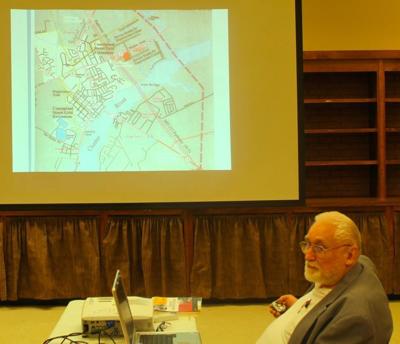CHESTERTOWN — What can be done about Washington Avenue traffic?
That was the topic of a presentation by Ted Byrne, a retired engineer and software designer, to a small group Saturday, March 28, at the Kent County Public Library in Chestertown.
Byrne used a PowerPoint presentation to frame his discussion of the issue, which has also been a concern of the Washington Avenue Neighborhood Association and the town’s planning commission. The program was sponsored by the League of Women Voters.
The talk focused on three possible approaches to fixing the problems, which include heavy truck traffic, backups at rush hour and speeds well above the stated 25 mph late at night.
The first approach would have the State Highway Administration “decide on changes as it sees fit.” That approach makes a degree of sense, since the street is also state Route 213, one of two main north-south routes on the Upper Shore. However, the comparatively small population of Kent County puts local problems low on the SHA’s priority list, Byrne said.
He cited studies by the SHA that seem to show most of the traffic entering town on Route 213 is “local” — in other words, Chestertown is the driver’s destination. Byrne was skeptical of these studies, which he said appear to be designed “to get the answer they (the SHA) wanted.” For example, the studies didn’t count cars crossing the Chester River bridge, one of the most important measures of the traffic coming to and through town.
The main SHA effort to divert traffic from town is promotion of U.S. Route 301 as the major north-south highway for the Upper Shore, Byrne said. He said there are already signs in Queen Anne’s County advising motorists to take Route 301 for the Upper Shore. However, Byrne said, the interchange to Route 213 near Galena is poorly designed for truck traffic. A redesign of that interchange would appear to be a prerequisite for encouraging trucks to and from Cecil County to use Route 301 instead of Route 213.
The second approach would be for Chestertown to take whatever steps it needs to improve traffic problems. That could involve making several more streets one-way and banning left turns at several corners, Byrne said. Restricting downtown parking could also be part of the solution, he said. However, none of these options would reduce noise or pollution from traffic through town, he said.
As a third possibility, Byrne also brought up the long-discussed and long-delayed option of an alternate route including a second Chester River bridge, usually referred to as “the bypass.” Official consideration of the bypass goes back to at least the 1970s, though there were locals who floated the idea a decade earlier. Byrne showed several maps of the proposed route.
But despite its being a stated “priority” for the SHA for 27 years, the bypass looks much like a dead end, partly because it has never had a strong constituency in Queen Anne’s County. “Half the people don’t want it,” Byrne said, describing how the SHA is likely to see the lack of support from Queen Anne’s residents.
There was considerable discussion of the bypass proposal. Byrne said the name should be changed to avoid negative associations — we want people to visit Chestertown, not bypass it, he said. He suggested calling it a parkway — a suggestion the town planning commission floated a few years ago.
The town might consider building its own bridge, but the cost would be prohibitive, he said; the state estimates the cost of a bridge plus a parkway at $480 million and up.
Byrne listed several advantages of a second bridge and parkway taking through traffic around the town. It would create sites for new recreational facilities such as parks and walking trails. It would become a natural location for auto repair shops and other motorist-related businesses. If there were mass transit available, it could have a park-and-ride lot, further reducing traffic on Route 213.
None of this will happen without concerted citizen action, Byrne said. Residents should work on making the alternate vision seem real, creating artwork to show what the town would look like with an uncrowded Washington Avenue. Also, he said, residents need to talk to SHA officials and local elected officials, including their delegates in the General Assembly.












(0) comments
Welcome to the discussion.
Log In
Keep it Clean. Please avoid obscene, vulgar, lewd, racist or sexually-oriented language.
PLEASE TURN OFF YOUR CAPS LOCK.
Don't Threaten. Threats of harming another person will not be tolerated.
Be Truthful. Don't knowingly lie about anyone or anything.
Be Nice. No racism, sexism or any sort of -ism that is degrading to another person.
Be Proactive. Use the 'Report' link on each comment to let us know of abusive posts.
Share with Us. We'd love to hear eyewitness accounts, the history behind an article.